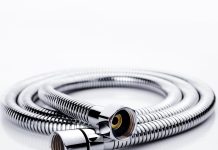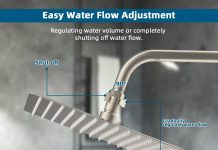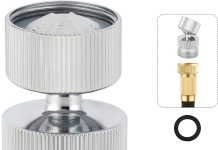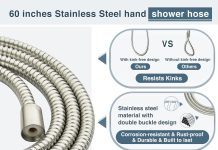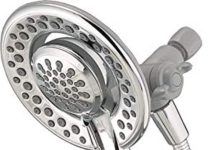Have you ever found yourself wishing for a more substantial water pressure while showering? We all agree that a weak water stream can be frustrating and underwhelming.
Thankfully, there are methods to boost your water pressure and enhance your showering experience. This article will explore various solutions and techniques to help you achieve a powerful and refreshing shower. Say goodbye to lackluster showers and hello to a refreshing and revitalizing bathing experience.
Table of Contents
Increasing Water Pressure in Showers
Are you tired of a lackluster shower that feels more like a drizzle than a refreshing stream? If so, you’re not alone.
Many people wish to increase the water pressure in their showers to enhance their bathing experience. Fortunately, there are several methods you can try to achieve that invigorating flow you desire.
This article will explore various approaches to boosting water pressure in showers, from simple DIY tasks to consulting with a professional plumber. So, let’s dive in and discover the ways to make your daily shower a more satisfying and refreshing experience.
Checking the Water Pressure
Before we delve into specific methods for increasing water pressure, it’s essential to establish a baseline by checking the existing water pressure in your shower. This will help you gauge whether your current pressure is low or just a matter of perception.
You only need a simple pressure gauge to perform this quick check, which can be purchased inexpensively at your local hardware store. Attach the gauge to a water outlet, turn on the faucet or shower, and note the reading. The standard water pressure for a shower should fall within the 40 to 60 pounds per square inch (psi) range. If your measurement is significantly lower, it may be time to take steps to increase the pressure.
Cleaning the Showerhead
A common culprit for low water pressure in the shower is a clogged or dirty showerhead. Over time, mineral deposits and sediment can accumulate inside the small openings, restricting the water flow. Before exploring other options, it’s a good idea to clean your showerhead to see if that resolves the issue.
Start by removing the showerhead from the arm, then soak it in warm water and vinegar. After 30 minutes, use a small brush, such as a toothbrush, to remove any residue. Rinse the showerhead thoroughly, reattach it to the arm, and test the water pressure. You may be pleasantly surprised at the difference a simple cleaning can make.
Removing Flow Restrictors
Many modern showerheads come equipped with flow restrictors designed to conserve water. While this may be great for the environment, it can damage your showering experience. Flow restrictors limit the water flow by reducing the shower’s gallons per minute (GPM) rate.
Removing the flow restrictor or replacing the showerhead with one that doesn’t have this feature can significantly increase water pressure. Remember that modifying or removing flow restrictors might lead to increased water consumption, so be conscious of your water usage after making these adjustments.
Upgrading the Plumbing System
If cleaning, removing flow restrictors, or replacing the showerhead didn’t yield satisfactory results, it might be worth considering upgrading your plumbing system. Older homes might have outdated pipes and fittings that restrict water flow. Replacing these components with modern, low-resistance alternatives can improve water pressure throughout your home, including the shower. Consult a professional plumber to assess your plumbing system and determine the most appropriate upgrades to suit your needs and budget.
Installing a Shower Pump
Installing a shower pump could be the ideal solution for those dealing with consistently low water pressure, especially in larger households. A shower pump increases water pressure by drawing water from a gravity-fed or low-pressure system and boosting it to the desired level.
The pump is typically installed near the water source and requires professional installation. While more expensive than others, a shower pump offers a long-term, reliable solution for low water pressure issues.
Adjusting the Pressure Regulator
A malfunctioning pressure regulator is another potential cause of low water pressure in your shower. Pressure regulators are usually installed near the water main and help maintain consistent pressure throughout your home. If the regulator is set too low or is faulty, it can result in poor water pressure.
To adjust the pressure regulator, locate it near the water meter or inside a pressure-reducing valve (PRV) box. Using a wrench, turn the adjusting screw clockwise to increase the pressure. If this doesn’t resolve the issue, it may be necessary to replace the regulator, which a professional plumber best does.
Checking for Leaks
Undetected leaks in your plumbing system can contribute to reduced water pressure. Even a tiny leak can cause a significant loss in pressure over time. To check for leaks, start by turning off all the water outlets in your home and monitor the water meter. If the meter continues to move, it could indicate a leak.
Additionally, visually inspect your pipes, faucets, and shower fixtures for any signs of water dripping or pooling. If you find a leak, it’s crucial to repair it promptly to prevent further water pressure issues. Depending on the severity of the leaks, this task may require the expertise of a professional plumber.
Using a High-Pressure Showerhead
If a complete overhaul of your plumbing system or installing a shower pump isn’t feasible, a high-pressure showerhead can provide a quick and convenient solution. These showerheads are specifically designed to increase water pressure by maximizing the force of water flow. They achieve this through features like smaller nozzle openings and adjustable spray patterns. Investing in a high-pressure showerhead can instantly transform your lackluster shower into a revitalizing experience that leaves you feeling refreshed and invigorated.
Using a Low-Flow Showerhead
While it may seem counterintuitive, opting for a low-flow showerhead can also help improve water pressure. Low-flow showerheads are designed to provide a satisfying showering experience while conserving water by limiting the flow rate. These showerheads use innovative technology to create a concentrated spray that feels powerful despite using less water. By switching to a low-flow showerhead, you help the environment and ensure adequate water pressure, making it a win-win solution.
Consulting a Professional Plumber
If you’ve exhausted all DIY methods and still haven’t achieved the desired water pressure in your shower, it’s time to call in the professionals. A licensed plumber can assess your specific situation and recommend the best course of action.
They have the knowledge and expertise to identify underlying issues, such as blocked pipes or plumbing system inadequacies, and provide tailored solutions to suit your needs. While it may require an additional expense, consulting a professional plumber ensures a proper and long-lasting resolution to your low water pressure dilemma.
In conclusion, upgrading the water pressure in your shower can significantly enhance your bathing experience. Whether it’s cleaning the showerhead, removing flow restrictors, or exploring more extensive plumbing modifications, various approaches exist. Following the steps outlined in this article, you can take control of your shower’s water pressure and transform it into a satisfying and refreshing ritual.
Remember, if all else fails, don’t hesitate to seek the guidance of a professional plumber who can provide expert advice and solutions tailored to your needs. So, go ahead and bid farewell to lackluster showers – it’s time to turn up the water pressure and indulge in the luxurious shower experience you deserve.


